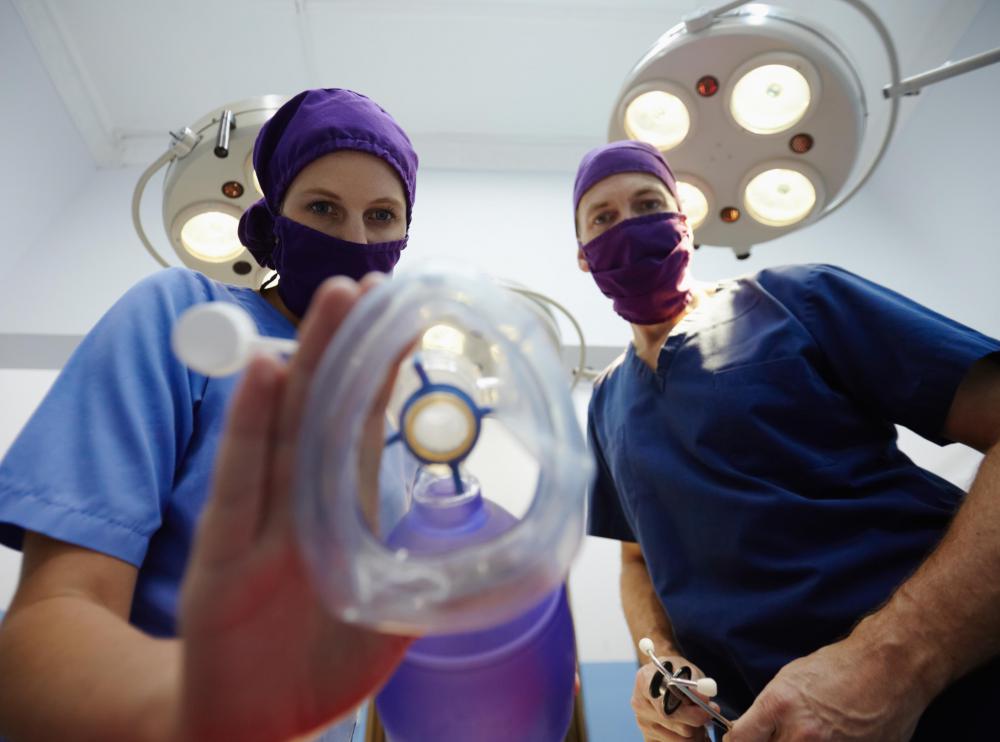At WiseGEEK, we're committed to delivering accurate, trustworthy information. Our expert-authored content is rigorously fact-checked and sourced from credible authorities. Discover how we uphold the highest standards in providing you with reliable knowledge.
What is Nitrous Oxide Sedation?
Nitrous oxide sedation is a form of inhaled sedation that reduces anxiety and relieves pain. Nitrous oxide is a colorless, odorless, and non-irritating gas that causes a feeling of euphoria. Nitrous oxide sedation typically uses approximately 30 percent nitrous oxide and 70 percent oxygen. The healthcare provider can adjust the ratio of nitrous oxide to oxygen to control the level of sedation provided.
Within two minutes of sedation, the patient will become lightheaded. A tingling sensation, most often in the arms and legs, is also common. The patient may also experience warmth, a feeling of well-being, or the sense that they are floating. If the patient becomes sleepy, begins crying, becomes giddy, or has trouble speaking, he or she may be over-sedated. Over-sedation can lead to nausea, vomiting, and unpleasant flashbacks.

A benefit of nitrous oxide sedation is that it moves in and out of the body quickly. If a patient receives too much nitrous oxide and feels nauseous, the healthcare provider can decrease the amount of nitrous oxide in the mix or the patient can simply remove the inhalation mask. The ease in which healthcare providers can control levels of sedation, the speed at which the sedating action takes effect and is eliminated from the body make nitrous oxide a popular choice for in-office procedures such as dental cleanings.

The method by which nitrous oxide works on the body is not fully understood, despite the fact that it has been in use since 1772. What is known is that nitrous oxide depresses the senses, including touch, pain, and hearing. It may also lower inhibitions in the parts of the brain that affect emotions. It does not appear to affect memory or concentration.

Nitrous oxide sedation is very safe for most people. Those with multiple sclerosis and emphysema, along with women in their first trimester of pregnancy, should avoid nitrous oxide. Individuals suffering from colds or others who have trouble breathing through their nose will not be able to use inhalation therapy. The major complication reported with nitrous oxide is over-sedation, which can be quickly remedied and presents no serious health complications.
AS FEATURED ON:
AS FEATURED ON:

















Discussion Comments
@I think that nitrous oxide works for more than just numbing a patient enough to get an anesthetic shot, but that is because it calms a patient in general. Going to the dentist is downright traumatic for a lot of people because folks tend to be terrified of the experience. Nitrous oxide helps put patients at ease and that may be the true value of it.
By the way, I learned when I was a kid that nitrous oxide makes me gabby. Drives dentists nuts. It won't work very well if you are constantly talking is what I learned.
I have never seen this in use outside of a dentist's office. The dentists I have always used tend to use this primarily to dull the patient a bit before numbing their mouth with a needle because those injections hurt like crazy.
Yes, the nitrous oxide tends to stay on throughout a treatment but it seems to me that it helps with the pain of the numbing shot more than anything else.
Post your comments